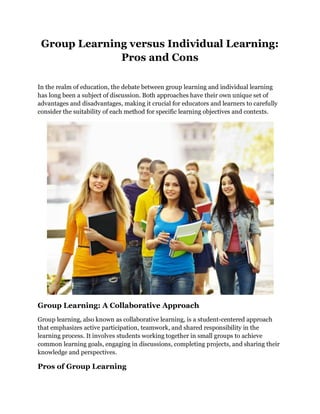
Group Learning versus Individual Learning Pros and Cons.pdf
- 1. Group Learning versus Individual Learning: Pros and Cons In the realm of education, the debate between group learning and individual learning has long been a subject of discussion. Both approaches have their own unique set of advantages and disadvantages, making it crucial for educators and learners to carefully consider the suitability of each method for specific learning objectives and contexts. Group Learning: A Collaborative Approach Group learning, also known as collaborative learning, is a student-centered approach that emphasizes active participation, teamwork, and shared responsibility in the learning process. It involves students working together in small groups to achieve common learning goals, engaging in discussions, completing projects, and sharing their knowledge and perspectives. Pros of Group Learning
- 2. 1. Enhanced Academic Performance: Group learning provides opportunities for students to clarify doubts, share different approaches, and learn from each other’s strengths. This collaborative approach can lead to a deeper understanding of the material, improved problem-solving skills, and enhanced academic performance. 2. Developed Social Skills: Group learning fosters social interaction, teamwork, and communication skills. Students learn to cooperate, resolve conflicts, and listen effectively to their peers, preparing them for success in collaborative environments. 3. Strengthened Communication Skills: Group learning encourages students to articulate their thoughts clearly, explain concepts to others, and actively listen to diverse perspectives. This promotes effective communication, public speaking skills, and the ability to express ideas confidently. 4. Boosted Self-Confidence: As students contribute to the group and witness their impact on the learning process, their self-confidence grows. They feel valued, motivated, and more engaged in the learning process. 5. Exposure to Diverse Perspectives: Group learning brings together students with different learning styles, backgrounds, and experiences. This exposure to diverse perspectives broadens their understanding of the world, encourages them to consider different viewpoints, and challenges them to think critically. Cons of Group Learning 1. Dependency on Others: Over-reliance on group members can hinder individual learning and comprehension. Students in a study group in college may develop a tendency to let others take the lead, reducing their own active participation and limiting their personal growth. 2. Communication Challenges: Group dynamics can influence the effectiveness of learning. Differences in personalities, learning styles, or work ethics can lead to conflicts, distractions, or unequal participation. 3. Free-Rider Effect: The “free-rider” effect can occur when some children study group members benefit from the efforts of others without contributing themselves. This can create resentment and undermine the overall effectiveness of the group. 4. Time Management: Coordinating group meetings, scheduling individual tasks, and ensuring equal participation can be time-consuming, potentially reducing the amount of time spent on individual learning and practice. Individual Learning: A Self-Paced Approach Individual learning, also known as independent learning, involves students working on their own as opposed to a children study group to achieve learning goals. It allows
- 3. for self-paced learning, personalized learning strategies, and focused attention on individual strengths and weaknesses. Pros of Individual Learning 1. Self-Paced Learning: Individual learning allows students to progress at their own pace, adjusting their learning speed to match their understanding and preferences. This personalized approach caters to individual needs and learning styles. 2. Focused Attention: Working independently eliminates distractions and allows for deep concentration on the learning material. Students can fully immerse themselves in the subject matter without external influences. 3. Develops Self-Discipline: Individual learning fosters self-discipline, time management skills, and a sense of responsibility for one’s own learning. Students learn to set goals, prioritize tasks, and manage their own learning process. 4. Promotes Critical Thinking: Individual learning encourages independent thought and critical analysis. Students must grapple with concepts on their own, developing their ability to evaluate information, form judgments, and make decisions. 5. Tailored Learning Strategies: Individual learning allows students to tailor their learning strategies to their own preferences and strengths. They can experiment with different techniques, identify effective approaches, and develop personalized learning plans. Cons of Individual Learning 1. Limited Exposure to Diverse Perspectives: Individual learning can limit exposure to different perspectives and approaches. Students may develop narrow views or miss out on valuable insights from peers. 2. Lack of Instant Feedback: Without immediate feedback from peers or instructors, students may struggle to identify errors or misunderstandings, potentially hindering their progress and comprehension. 3. Increased Risk of Misconceptions: Individual learners may develop misconceptions or misunderstandings without the guidance or feedback of others. This can lead to difficulties in understanding more complex concepts later on. 4. Potential for Isolation: Individual learning can lead to feelings of isolation or disengagement from the learning community. Students may miss out on social interactions, peer support, and the sense of belonging that group learning provides. Conclusion: Choosing the Right Approach
- 4. The choice between group learning and individual learning depends on various factors, including the learning objectives, the nature of the subject matter, and the individual. We invite you to explore Explain Learning to start your learning journey. Content source Group Learning versus Individual Learning: Pros and Cons
